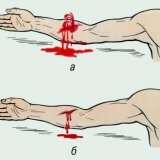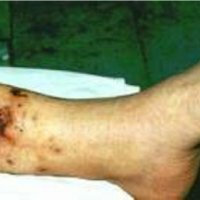Types of external bleeding

Bleeding - the outflow of blood from the vessels due to violation of integrity or damage to their walls. External bleeding is distinguished by the appearance of blood outward, through a defect, damage to the skin. The danger and nature of the external bleeding that occurs in a person are directly dependent on which vessel is damaged. In any case, bleeding is an insidious phenomenon, since it can cause significant blood loss, which negatively affects human health, and sometimes even leads to death.
Are divided into the following types of bleeding:
- venous;
- arterial;
- is capillary;
- is parenchymal.
Venous
Venous bleeding occurs due to damage to the veins. Unlike arteries, the blood pressure in the veins is much lower, so it follows a continuous, uniform stream. Blood for this type of bleeding is colored dark red. Depending on the movements of the chest( breathing), blood pressure in large veins varies very significantly. Even inhalation in large cervical veins may cause negative pressure. With venous bleeding, there is a risk of a so-called air embolism. This can be seen from the gaping wounds on the vein. Thus air arrives in a vein aperture and with a blood stream gets to heart that can pour out in blockage of vessels. This can lead to immediate death of a person.
Arterial
Arterial refers to bleeding originating from damaged arteries. This type of external bleeding is the most dangerous. Poured blood has a bright red color, and is thrown outward by a fairly powerful pulsating jet. If a large artery is damaged in a person, the bleeding is severe and prolonged, this can lead to a serious condition of the patient or even a lethal outcome. The greatest danger of this type of bleeding( external) is a very rapid decrease in the volume of circulating blood, which can lead to circulatory disorders and irreversible changes in the kidneys, brain and other organs of man.
Capillary
Capillary refers to bleeding caused by damage to the smallest blood vessels, which are called capillaries. This type of external bleeding may occur because of slight damage to the skin, for example, shallow cuts. As a rule, such a bleeding is very easy to stop. You just need to put a bandage on the damaged skin area, and after a while the bleeding will stop. But this applies only to those people who have normal blood coagulability.
Parenchymal
Parenchymal hemorrhage. Kidneys, liver, spleen and other human organs have a very extensive network of venous and arterial vessels. Due to damage to any of these organs, very heavy parenchymal bleeding occurs. Since with this type of bleeding vessels are in the tissue of the organ, spontaneous stopping occurs rarely.
Hemorrhages differ in development time. The flow of blood, observed at the time of damage to the vessel, is called primary bleeding. Bleeding that appears on the damaged area after a certain period of time after the trauma, as a result of its complications, is called secondary.
Bleeding can also be single or repeated. Secondary, especially late, bleeding, usually are repeated. The most significant signs of repeated external bleeding are: the appearance of a hematoma or their enlargement, an increase in body temperature, the appearance of blood clots on the damaged area.
Bleeding sizes directly depend on the type of damaged blood vessel and on the nature of the damage. With a complete vertical break of the artery, its ends contract, and the inner shell is absorbed inwards, which significantly reduces the lumen of the blood vessel. Occasionally, the mashed ends of the ruptured vessel stick together. All this can lead to the formation of a thrombus and spontaneous cessation of bleeding.
In the case of lateral vascular damage, these mechanisms are more pronounced or not apparent at all. Important importance in the spontaneous stopping of external bleeding has neuro-reflex effects. This is the reduction and expansion of damaged vessels in separation from the wound site, which lead to hypotension. A significant loss of blood also causes a drop in blood pressure, which leads to a halt in bleeding.
It often happens that bleeding from minor wounds stops spontaneously. This is explained by a whole set of protective mechanisms of the human body.
The main role in self-stopping bleeding is performed by spasms, as well as contractions of damaged blood vessels, a reflex decrease in the volume of circulating blood in the area of injury, an increase in the ability of blood clotting. Spillage blood coagulates for a short time and closes the damaged vessel. With capillary or venous bleeding, spontaneous arrest, as a rule, is final.
There are cases when bleeding even from large vessels stopped spontaneously. But such a stop is not reliable. It is only necessary to load a damaged organ a little, the pressure will increase, the blood formed on the wound will disappear and the bleeding will begin again, and it may be more severe than the original one.
Hemophilia.
Hemophilia is a hereditary disease characterized by reduced blood coagulability. Even small scratches and abrasions can cause prolonged bleeding.
We hope that the described types of external bleeding will help you learn more about various bleeding and understand how often some of them are dangerous. We wish you good health.



